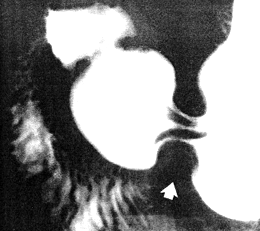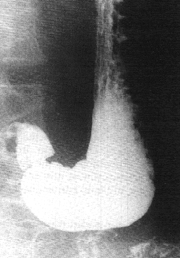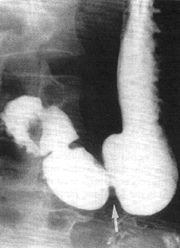


Go to chapter: 1 | 2 | 3 | 4 | 5 | 6 | 7 | 8 | 9 | 10 | 11 | 12 | 13 | 14 | 15 | 16 | 17 | 18 | 19 | 20 | 21 | 22 | 23 | 24 | 25 | 26 | 27 | 28 | 29 | 30 | 31 | 32 | 33 | 34 | 35 | 36 | 37 | 38 | 39
Chapter 13 (page 60)




Go to chapter: 1 | 2 | 3 | 4 | 5 | 6 | 7 | 8 | 9 | 10 | 11 | 12 | 13 | 14 | 15 | 16 | 17 | 18 | 19 | 20 | 21 | 22 | 23 | 24 | 25 | 26 | 27 | 28 | 29 | 30 | 31 | 32 | 33 | 34 | 35 | 36 | 37 | 38 | 39
Chapter 13 (page 60)
 |
Fig. 13.13. Left pyloric loop (arrow) tightly contracted, almost bisecting lumen. Right loop (i.e. muscular part of pyloric ring) not contracted and aperture patent |
This process is well seen during gastric emptying of liquid barium, as illustrated in the
following representative case:
Case J.V., male aged 35 years. A motor quiescent stage was awaited in which the
stomach and duodenal bulb were filled; as often happens in the absence of motor
activity, filling of the remainder of the duodenum was in abeyance. The pyloric
sphincteric cylinder was relaxed; the aperture was patent, measuring 10.0 mm in
diameter (Fig 13.14A). When gastric motor activity resumed, a stage was
awaited at which the first peristaltic wave became stationary, immediately prior to
contraction of the cylinder (Fig 13.14B). Immediate filling of the remainder
of the duodenum ensued. The pyloric aperture widened marginally, now measuring 12.0
mm in diameter.
A |  B B |
| Fig. 13.14. A,B. Case J.V. A Motor quiescent phase. Pyloric sphincteric cylinder relaxed. Pyloric aperture patent. Duodenal bulb filled. B Peristaltic wave stationary and commencing contraction of left pyloric loop (arrow). Filling of remainder of duodenum. Marginal widening of aperture. | |
This and similar cases show that gastric emptying of liquid barium may be associated
with arrival of a peristaltic wave at the commencement of the sphincteric cylinder.
Arrival of a peristaltic wave here may also be associated with marginal further widening
of the already patent pyloric aperture.
On the other hand the right loop may be fully contracted, closing the pyloric aperture,
while the left loop is incompletely contracted, surrounding a central aperture. In this
instance contraction of the sphincteric cylinder is associated with orad movement of
barium, i.e. retropulsion. (An example of retropulsion is to be described in Case G.O.,
under "Mucosal Movements").
Previous Page | Table of Contents | Next Page
© Copyright PLiG 1998